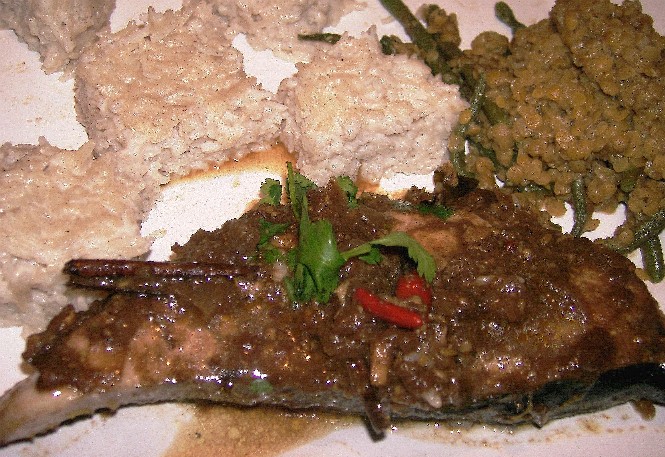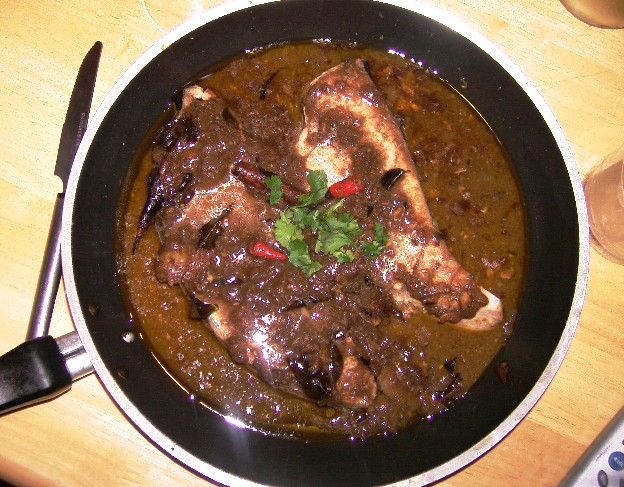

I often wonder what it is that makes a certain cuisine popular across the world. For example, why has Chinese food taken off in almost every country whereas say, Carribean cuisine, which in my opinion just as good or maybe even better, only seen in a few places where there are large communities of immigrants?
Sri Lankan cuisine is like this too. Who here has heard of string hoppers, kothu roti or lunu miris? Not many of you I imagine. Despite the cosmopolitan nature of modern Britain, the cuisine has remained almost completely unknown. I wonder what has made it this way. It can’t be the use of chilli and spice. Maybe it’s the way they (by our standards) overcook some things or the fact that dark brown sauces aren’t all that attractive?
Perhaps that is a question for the people with proper culinary training. What I really want to talk about is ambul thiyal. This is a very popular dish of a fish steak (usually an oily fish like kingfish) in a sour curry sauce. Sri Lanka has a great selection of delicious fish. However on the rare occasions I’m there, eating the curried fish makes me cringe. It’s frequently over-salted and overcooked, sometimes it is also overspiced. Living in London, a place where this beautiful oily fish is so expensive to buy, I hate seeing it put to waste.
In spite of this I DO like the flavours in Sri Lankan curries and for a while I’ve had a craving for ambul thiyal. I was wondering if there was any way I could take this traditional dish and alter it to really take advantage of it’s main ingredient and make it more acceptable to a British palate like mine.
I had two juicy swordfish steaks from Borough that would be perfect for this experiment. Many recipes for ambul thiyal suggest using tuna. I disagree. I think the sourness of the sauce wouldn’t really complement the flavour of the tuna (although, since tuna loses some of it’s flavour when overcooked, it is fine for the dish after about ten minutes in the pan). Swordfish or marlin, which work so well with a tangy hollandaise, would be much better choices.
Traditional recipes call for pieces of fish to be boiled with a variety of spices (including cinnamon, fennel seed and curry leaves) in water, tamarind and vinegar until you have a thick gravy and very well done fish. I say bugger that. Especially since my swordfish had set me back £10 for half a kilo. My plan was to marinate the fish well, make the curry sauce separately and then pan fry until it was just pink in the center and moist and juicy all the way through.
Into my fish marinade went 1 large clove of crushed garlic, a tablespoon of grated ginger, a little grated lemon zest, a teaspoon of ground fennel and half a teaspoon of ground cinnamon all mixed together with enough chilli oil to coat the fish. I scored the fish all over then coated it with the marinade and left it for about 90 minutes, turning it every fifteen minutes or so.
The sauce was made by frying a small minced onion gently in vegetable oil with a couple of chopped birds eye chillies, fennel seed, crushed black peppercorns, a cinnamon stick, thin slices of lemon zest, curry leaves, ginger and crushed garlic. When the onion was soft I added 500ml of fish stock and let it boil. When it had reduced by half, I tasted it and decided it needed something. I added some ground coriander and ground fennel. When most of the liquid had boiled away, I took half a tablespoon of tamarind paste and mixed it with water and added that to the curry. Then I added white wine vinegar a little at a time until I was happy with the flavour. I let the mixture reduce to a thick gravy, tasted again, and added more pepper.
At this point I took the sauce off the heat and cooked my swordfish steaks on a high heat for two minutes a side. Finally I poured the sauce over the fish and let it sit at room temperature until I finished off my kiribath accompaniment and some green beans with dahl.

Well, I don’t know what my Dad would say to this. Probably something like “this fish is raw,” which it wasn’t. Unfortunately Dad doesn’t know there’s an intermediate stage between raw and charcoal. I bet Mum would have liked it though.
The ambul thiyal gravy certainly tasted very similar to the authentic version. I think my addition of ground coriander worked well. I get the feeling that, without it, the sauce would be a bit ‘thin’ on flavour. The ground fennel was also a good idea. The flavour from the whole seeds was a touch too subtle. In this version of the dish, I think the fish stock is essential, as the curry sauce isn’t actually cooked with the fish steaks and hence gains no flavour from them.
The ambul thiyal certainly worked well for me. Goon said he liked it but he said he thinks swordfish is better with hollandaise, even though he’s not sure he’s ever had hollandaise. Someone figure that one out for me.  I do prefer swordfish with hollandaise. But a change every now and again is good and this curry certainly complemented the fish well. Experiment succesful.
I do prefer swordfish with hollandaise. But a change every now and again is good and this curry certainly complemented the fish well. Experiment succesful. 
I often wonder what it is that makes a certain cuisine popular across the world. For example, why has Chinese food taken off in almost every country whereas say, Carribean cuisine, which in my opinion just as good or maybe even better, only seen in a few places where there are large communities of immigrants?
Sri Lankan cuisine is like this too. Who here has heard of string hoppers, kothu roti or lunu miris? Not many of you I imagine. Despite the cosmopolitan nature of modern Britain, the cuisine has remained almost completely unknown. I wonder what has made it this way. It can’t be the use of chilli and spice. Maybe it’s the way they (by our standards) overcook some things or the fact that dark brown sauces aren’t all that attractive?
Perhaps that is a question for the people with proper culinary training. What I really want to talk about is ambul thiyal. This is a very popular dish of a fish steak (usually an oily fish like kingfish) in a sour curry sauce. Sri Lanka has a great selection of delicious fish. However on the rare occasions I’m there, eating the curried fish makes me cringe. It’s frequently over-salted and overcooked, sometimes it is also overspiced. Living in London, a place where this beautiful oily fish is so expensive to buy, I hate seeing it put to waste.
In spite of this I DO like the flavours in Sri Lankan curries and for a while I’ve had a craving for ambul thiyal. I was wondering if there was any way I could take this traditional dish and alter it to really take advantage of it’s main ingredient and make it more acceptable to a British palate like mine.
I had two juicy swordfish steaks from Borough that would be perfect for this experiment. Many recipes for ambul thiyal suggest using tuna. I disagree. I think the sourness of the sauce wouldn’t really complement the flavour of the tuna (although, since tuna loses some of it’s flavour when overcooked, it is fine for the dish after about ten minutes in the pan). Swordfish or marlin, which work so well with a tangy hollandaise, would be much better choices.
Traditional recipes call for pieces of fish to be boiled with a variety of spices (including cinnamon, fennel seed and curry leaves) in water, tamarind and vinegar until you have a thick gravy and very well done fish. I say bugger that. Especially since my swordfish had set me back £10 for half a kilo. My plan was to marinate the fish well, make the curry sauce separately and then pan fry until it was just pink in the center and moist and juicy all the way through.
Into my fish marinade went 1 large clove of crushed garlic, a tablespoon of grated ginger, a little grated lemon zest, a teaspoon of ground fennel and half a teaspoon of ground cinnamon all mixed together with enough chilli oil to coat the fish. I scored the fish all over then coated it with the marinade and left it for about 90 minutes, turning it every fifteen minutes or so.
The sauce was made by frying a small minced onion gently in vegetable oil with a couple of chopped birds eye chillies, fennel seed, crushed black peppercorns, a cinnamon stick, thin slices of lemon zest, curry leaves, ginger and crushed garlic. When the onion was soft I added 500ml of fish stock and let it boil. When it had reduced by half, I tasted it and decided it needed something. I added some ground coriander and ground fennel. When most of the liquid had boiled away, I took half a tablespoon of tamarind paste and mixed it with water and added that to the curry. Then I added white wine vinegar a little at a time until I was happy with the flavour. I let the mixture reduce to a thick gravy, tasted again, and added more pepper.
At this point I took the sauce off the heat and cooked my swordfish steaks on a high heat for two minutes a side. Finally I poured the sauce over the fish and let it sit at room temperature until I finished off my kiribath accompaniment and some green beans with dahl.
Well, I don’t know what my Dad would say to this. Probably something like “this fish is raw,” which it wasn’t. Unfortunately Dad doesn’t know there’s an intermediate stage between raw and charcoal. I bet Mum would have liked it though.
The ambul thiyal gravy certainly tasted very similar to the authentic version. I think my addition of ground coriander worked well. I get the feeling that, without it, the sauce would be a bit ‘thin’ on flavour. The ground fennel was also a good idea. The flavour from the whole seeds was a touch too subtle. In this version of the dish, I think the fish stock is essential, as the curry sauce isn’t actually cooked with the fish steaks and hence gains no flavour from them.
The ambul thiyal certainly worked well for me. Goon said he liked it but he said he thinks swordfish is better with hollandaise, even though he’s not sure he’s ever had hollandaise. Someone figure that one out for me. ![]() I do prefer swordfish with hollandaise. But a change every now and again is good and this curry certainly complemented the fish well. Experiment succesful.
I do prefer swordfish with hollandaise. But a change every now and again is good and this curry certainly complemented the fish well. Experiment succesful. ![]()


